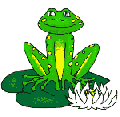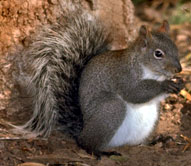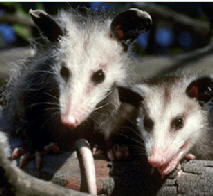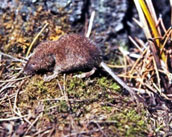|
Tule
Ponds at Tyson
MAMMALS
NATIVE |
 |
 Gopher Gopher
Thomomys bottae
Long claws on
the forefeet and heavy shoulder muscles make gophers superb diggers.
They carry food in fur-lined pouches on either side of their mouth.
A furry membrane behind the incisors keeps dirt out of the mouth
while the gopher is digging. The earth mounds that are pushed out
during the gophersí search for food have a distinct earthen plug at
the center or the side. Gophers plow the land and bring tons of
soil to the surface each year, stimulating plants to grow larger and
healthier. Pocket gophers are solitary except during the breeding
season and usually expel intruders from their burrow system.
However, abandoned gopher burrows often provide essential refuge
for a variety of other animals. Gophers are prey for hawks, owls,
fox, cats and snakes. |
|
 Western Gray squirrel Western Gray squirrel
Sciurus griseus
The western gray squirrel
is silver gray with white undersides. It has a characteristic long
bushy tail. The gray squirrel lives for 7 to 8 years. It mainly
eats seeds, but known to eat berries, fungus, bark, sap, and
insects. It can live in hollow trees or nests. |
|
 Muskrat Muskrat
Ondatra zibethicus
This aquatic rodent lives
in marsh environments. They are excellent swimmers and can stay
under water for more than 15 minutes at a time. Their houses are
made of bulrushes, reeds, and packed mud. There are separate
sleeping platforms for each member of the family. They also build
dens in stream banks with the entrance underwater. They eat
cattails, bulrush, crayfish, and fish. Their total body length is
about 30 cm. The muskratís tail is flat and scaly up to 20 cm long
It has a large head, small ears, short legs, and webbed feet. |
|
 Opossum Opossum
Didelphis marsupialis
This is the only North
American marsupial or pouched mammal, It has a pointed stout,
grayish fur, a long hairless rat-like tail. There may be up to 14
young in a litter. At birth, an entire litter could fit in a
teaspoon! They remain in their motherís pouch for about 2 months.
Later they travel on her back with their tails grasping hers. |
|
 Raccoon Raccoon
Procyon lotor
The raccoon has a black
mask over its eyes and a bushy tail with 4-10 black rings. Its
forepaws resemble slender human hands with 5 toes. The raccoon is
omnivorous and feeds on crayfish in the creek as well as
blackberries. |
|
 Shrews Shrews
Sorex spp
Shrews are
insect eaters. They are very small and need to eat frequently
because of their high metabolic rate. The species most likely
include the Ornate Shrew (Sorex ornatus) and the Trowbridge
Shrew (Sorex trowbridgei). |
|